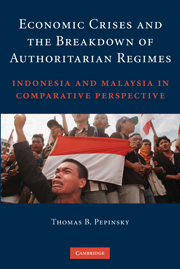 Economic Crises and the Breakdown of Authoritarian Regimes
Economic Crises and the Breakdown of Authoritarian Regimes Published online by Cambridge University Press: 21 January 2010
Two Countries, Two Trajectories
On the morning of July 14, 1997, citizens of Jakarta and Kuala Lumpur awoke to a new world. The difference from the previous day was seemingly minor and distant – several hundred miles to the north, the government of Thailand had abandoned its long-standing informal currency peg of the baht to the American dollar. Few would have believed that this decision was the first in a chain of events that would fundamentally remake the political economy of Southeast Asia. Even as foreign investors turned their eyes toward other Asian countries, reconsidering the health of their financial systems, political and economic upheaval seemed unlikely. Indonesia and Malaysia had long embraced the world economy. They were competently run economies with popular leaders who had engineered decades of impressive economic growth. Despite their excesses, authoritarian rule in each country bred stability, prosperity, and development.
A year later, Indonesia and Malaysia were in turmoil. Sustained capital outflows and currency speculation had led to massive depreciation of the rupiah and ringgit and heavy losses in each country's stock market. Economic growth, which for a decade had been among the highest in the world, became economic collapse – GDP contracted nearly 8 percent in Malaysia and more than 13 percent in Indonesia during 1998. In each country, thousands of borrowers in the business community were unable to service their debts. Financial upheaval forced both countries to seek emergency funds from foreign donors to keep their once-buoyant economies afloat.
To save this book to your Kindle, first ensure [email protected] is added to your Approved Personal Document E-mail List under your Personal Document Settings on the Manage Your Content and Devices page of your Amazon account. Then enter the ‘name’ part of your Kindle email address below. Find out more about saving to your Kindle.
Note you can select to save to either the @free.kindle.com or @kindle.com variations. ‘@free.kindle.com’ emails are free but can only be saved to your device when it is connected to wi-fi. ‘@kindle.com’ emails can be delivered even when you are not connected to wi-fi, but note that service fees apply.
Find out more about the Kindle Personal Document Service.
To save content items to your account, please confirm that you agree to abide by our usage policies. If this is the first time you use this feature, you will be asked to authorise Cambridge Core to connect with your account. Find out more about saving content to Dropbox.
To save content items to your account, please confirm that you agree to abide by our usage policies. If this is the first time you use this feature, you will be asked to authorise Cambridge Core to connect with your account. Find out more about saving content to Google Drive.